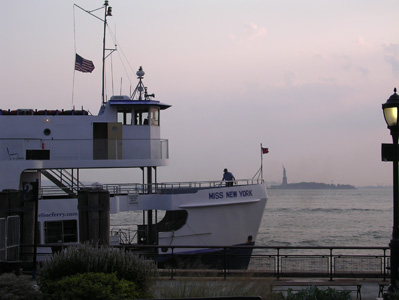On September 11th, 2001, as hundreds of thousands fled south from the burning towers, people quickly discovered something we often forget: Manhattan is an island. As officials closed all bridges, tunnels and commuter lines linking Manhattan to the rest of the world, people were trapped.

On September 11, 2001, ferryboats and other available vessels evacuated over 500,000 people from Manhattan Island. Photo by Patrick Runkle
By Patrick Burnson
Published: October, 2011
On September 11th, 2001, as hundreds of thousands fled south from the burning towers, people quickly discovered something we often forget: Manhattan is an island. As officials closed all bridges, tunnels and commuter lines linking Manhattan to the rest of the world, people were trapped.
The little-told story of what happened next is the focus of a recent documentary short film, Boatlift, narrated by Tom Hanks. The film premiered at the Center for National Policy’s 9/11 Ten Year Anniversary Summit, in Washington, D.C.
Boatlift is the story of the largest maritime evacuation in history. On 9/11, over 500,000 people were rescued from Manhattan’s seawalls in just nine hours. What heroism made this possible? The answer lies in the resilience of the every day people at the scene that day, and the brave community of mariners who ply the waters of New York City.
As the buildings fell, hundreds of tugboats, ferries, fishing boats, coast guard cutters and other vessels rushed towards the disaster. They did so at great personal risk. James Parese, the captain of the Staten Island Ferry, assumed he might be next: "We’re a big orange target in the middle of that harbor."
Vincent Ardolino, captain of the Amberjack V, was at home in Brooklyn, watching the burning buildings on TV. He said, "I gotta go do something," kissed his wife goodbye and dashed to his charter boat.
These men, and hundreds like them, pushed their boats into the harbor, and filled them over and over again with dazed passengers. That the evacuation was unplanned and unrehearsed is remarkable. But what is even more impressive is that not a single person was injured in the process.
The story of the 9/11 boatlift is a reminder of the sense of shared purpose and resilience that pervaded New York—and the world—in the immediate aftermath of the attacks. As Stephen Flynn from the Center for National Policy said, "First responders will always do their best to assist us. But, in real life, success or failure in our moments of greatest need is usually determined by the actions of regular people."
Boatlift pays tribute to some of those who answered the call on 9/11/2001. We should all be prepared to do the same. The film can be viewed online at silive.com, use keyword boatlift in the site search tool.
Port of Oakland Finds New Funding
The Port of Oakland announced the successful sale of $345.73 million in 2011 Series O (AMT) refunding revenue bonds for the purpose of refunding a portion of its outstanding debt. Through this transaction, the Port achieved $29.2 million in present value debt service savings, and was able to both maximize near-term savings and smooth debt service payments over the next eight years, a period in which the port’s debt remains at peak or near-peak levels.
Bond refunding is the process by which new bonds are issued at lower interest rates to replace higher interest rate bonds that are currently outstanding in order to achieve cost savings. Bonds are the main type of debt that the Port holds.
"Debt is weighing down all levels of government and the average citizen, hampering economic recovery—the Port of Oakland is no exception. That is why we have been vigilantly monitoring the markets in order to achieve savings on our outstanding bond debt," said Port Commission President Pamela Calloway. "While my colleagues and I on the Board of Port Commissioners are pleased with the savings achieved, we will continue to push the organization to aggressively seek savings, investments, grants, public-private partnerships and business growth to get us back on a track toward competitive sustainability."
Even at the height of the bond market during the fall of 2010, this level of savings was not available. In spite of the turbulent markets over the last nine months, the port was able to obtain very low interest rates. The resulting savings are the highest known level of savings achieved by the port on a bond refunding.

